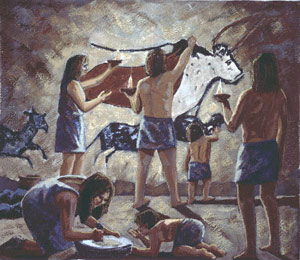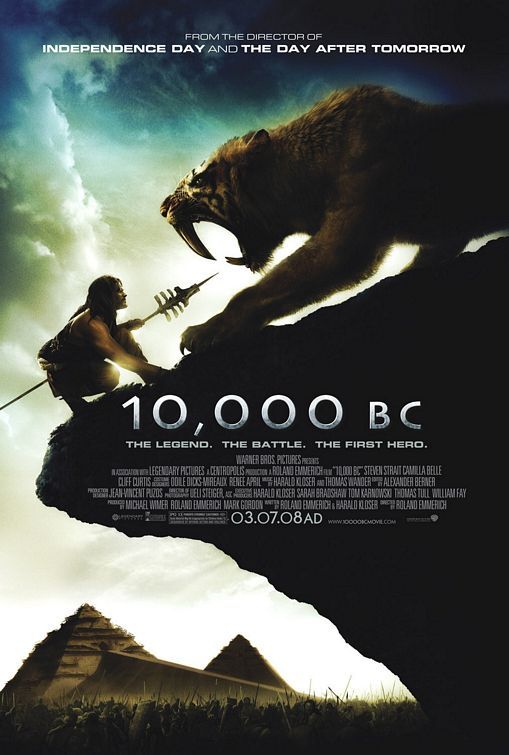Unit 3 Early Humans Online Review Quiz

This quiz will help prepare you for the Unit 3 Test or for the RAP test.
- 1.
If you were studying the Civil War, an an actual letter written during the Civil War would be a ______________ (type primary source, secondary source, or neither one). SPELLING COUNTS!
Explanation
It was written during the time period being studied!Rate this question:
- 2.
If you were studying World War II, a textbook about World War II would be a ______________ (type primary source, secondary source, or neither one). SPELLING COUNTS!
Explanation
It was created after World War II.Rate this question:
- 3.
If you were studying 10,000 BC, this fiction movie is a ________________ (type primary source, secondary source, or neither one). SPELLING COUNTS!
Explanation
Fiction means made up. Fiction movies might be based on events from history but they are not historical sources.Rate this question:
- 4.
If you are studying World War II, a fiction novel about World War II is a ____________________ (type primary source, secondary source, or neither one).
Explanation
Fiction novels are not historical sources!Rate this question:
- 5.
Which of the following time periods is a millennium?
- A.
1100 to 1200
- B.
1864 to 1860
- C.
1300 to 1310
- D.
1000 to 2000
Correct Answer
D. 1000 to 2000Explanation
Millennium = 1,000 years. (Think of Spanish "un mil")Rate this question:
-
- 6.
How long does a century last?
- A.
It can be long or short but it has to share common events or features.
- B.
Ten years.
- C.
One hundred years.
- D.
One thousand years.
Correct Answer
C. One hundred years.Explanation
A century refers to a period of one hundred years. It is a commonly accepted unit of time measurement and is widely used in various fields such as history, sports, and calendars. Therefore, the correct answer is one hundred years.Rate this question:
-
- 7.
A.D. stands for "After Death."
- A.
True
- B.
False
Correct Answer
B. FalseExplanation
It stands for "Anno Domini" which means "Year of the Lord" in Latin.Rate this question:
-
- 8.
A decade lasts __________ years. (Use numbers or letters).
Correct Answer
10
tenExplanation
A decade is a period of ten years, which is represented by the number 10 or the word "ten".Rate this question:
- 9.
To figure out how many years passed between 600 B.C. and 300 B.C., use this mathematical operation.
- A.
Addition
- B.
Subtraction
- C.
Multiplication
- D.
Division
Correct Answer
B. SubtractionExplanation
To figure out how many years passed between 600 B.C. and 300 B.C., we need to subtract the starting year (600 B.C.) from the ending year (300 B.C.). Subtraction is the correct mathematical operation to use in this case. By subtracting 300 from 600, we can determine that 300 years passed between the two given years.Rate this question:
-
- 10.
To find how many years passed between 5,000 B.C. and 2010 A.D., use this mathematical operation:
- A.
Addition
- B.
Subtraction
- C.
Multiplication
- D.
Division
Correct Answer
A. AdditionExplanation
To find how many years passed between 5,000 B.C. and 2010 A.D., we need to add the number of years from 5,000 B.C. to 1 A.D. and then add the number of years from 1 A.D. to 2010 A.D. Adding these two values will give us the total number of years that have passed between the two time periods. Therefore, addition is the correct mathematical operation to use in this case.Rate this question:
-
- 11.
These dates are in correct chronological order:1 B.C., 2 B.C., 3 B.C.
- A.
True
- B.
False
Correct Answer
B. FalseExplanation
B.C. would count DOWN to zero: 3 B.C., 2 B.C., 1 B.C.Rate this question:
-
- 12.
Why did early humans migrate so often?
- A.
To find food
- B.
Because of diseases
- C.
Wars with other tribes
- D.
Because of the climate
Correct Answer
A. To find foodExplanation
Hunter-gatherers need to migrate frequently to find food.Rate this question:
-
- 13.
What was the Neolithic Revolution
- A.
When people invented architecture.
- B.
When people invented hunting and gathering.
- C.
When people invented agriculture.
- D.
When people invented bartering.
Correct Answer
C. When people invented agriculture.Explanation
The Neolithic Revolution refers to the major shift in human society from a nomadic, hunter-gatherer lifestyle to a settled, agricultural lifestyle. This revolution occurred around 10,000 BCE when people began to domesticate plants and animals, leading to the development of farming and the establishment of permanent settlements. This transition from a primarily food-gathering economy to an agricultural one had a profound impact on human civilization, enabling the growth of larger communities, the development of specialized skills, and the emergence of complex social structures.Rate this question:
-
- 14.
Hunter-gatherers have
- A.
A subsistence economy with some bartering
- B.
A market economy with some agriculture
- C.
A specialized economy with some trading
Correct Answer
A. A subsistence economy with some barteringExplanation
In a susistence economy, people work hard to survive. They have little spare time for specializing.Rate this question:
-
- 15.
Which statements describe effects of the Neolithic Revolution?
- A.
The population increased
- B.
The population declined
- C.
People became nomadic
- D.
People stopped being nomadic and made permanent villages
- E.
There was a food surplus
- F.
The first social classes developed
Correct Answer(s)
A. The population increased
D. People stopped being nomadic and made permanent villages
E. There was a food surplus
F. The first social classes developedExplanation
The Neolithic Revolution, also known as the Agricultural Revolution, marked a significant shift in human history. As people transitioned from a hunter-gatherer lifestyle to settled farming communities, several effects occurred. Firstly, the population increased as agriculture provided a more reliable and abundant food supply. Secondly, people stopped being nomadic and began to establish permanent villages, as they no longer needed to constantly move in search of food. This change also led to a food surplus, allowing for specialization of labor and the development of the first social classes.Rate this question:
-
- 16.
Having surplus goods means that you can:
- A.
Produce just enough to meet your needs.
- B.
Hunt and gather.
- C.
Trade with others.
- D.
Be a leader.
Correct Answer
C. Trade with others.Explanation
Surplus means extra.Rate this question:
-
- 17.
During the Paleolithic Age, banks, money and taxes did not exist.
- A.
True
- B.
False
Correct Answer
A. TrueExplanation
Only bartering or trading existed. Most people hunted, gathered, and made everything they needed.Rate this question:
-
- 18.
A direct result of the Neolithic Revolution is that people
- A.
Began living in permanent villages
- B.
Developed a nomadic way of life
- C.
Depended on hunting and gathering
- D.
Used fertilizers
Correct Answer
A. Began living in permanent villagesExplanation
The Neolithic Revolution refers to the transition from a hunter-gatherer lifestyle to a settled agricultural lifestyle. This shift allowed people to domesticate plants and animals, leading to the development of agriculture. As a result, people began to live in permanent villages as they no longer needed to constantly move in search of food. This change in lifestyle was a direct consequence of the Neolithic Revolution.Rate this question:
-
- 19.
What invention caused early people to stop roaming?
- A.
Ziggurats
- B.
The wheel
- C.
Fire
- D.
Agriculture
Correct Answer
D. AgricultureExplanation
Agriculture means farming. When you farm you have to be near your crops to take care of them.Rate this question:
-
- 20.
This picture shows people:
- A.
Buying and selling
- B.
Specializing
- C.
Farming
- D.
Bartering
Correct Answer
D. BarteringExplanation
The picture depicts people engaging in bartering, which is the exchange of goods or services without the use of money. This is evident from the fact that there are no monetary transactions taking place, but rather individuals are seen trading or swapping items directly. Bartering was a common practice in early civilizations before the invention of currency, and it allowed people to obtain the goods they needed by exchanging surplus items they possessed.Rate this question:
-
Quiz Review Timeline +
Our quizzes are rigorously reviewed, monitored and continuously updated by our expert board to maintain accuracy, relevance, and timeliness.
-
Current Version
-
Mar 19, 2023Quiz Edited by
ProProfs Editorial Team -
Dec 02, 2010Quiz Created by
Ms.sutherland
 Back to top
Back to top




